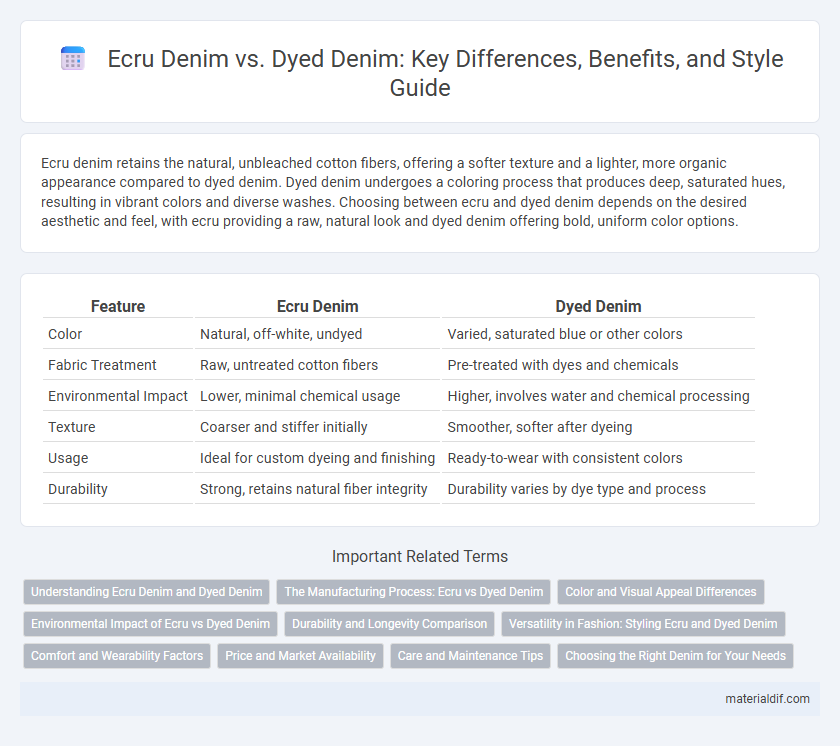Ecru denim retains the natural, unbleached cotton fibers, offering a softer texture and a lighter, more organic appearance compared to dyed denim. Dyed denim undergoes a coloring process that produces deep, saturated hues, resulting in vibrant colors and diverse washes. Choosing between ecru and dyed denim depends on the desired aesthetic and feel, with ecru providing a raw, natural look and dyed denim offering bold, uniform color options.
Table of Comparison
| Feature | Ecru Denim | Dyed Denim |
|---|---|---|
| Color | Natural, off-white, undyed | Varied, saturated blue or other colors |
| Fabric Treatment | Raw, untreated cotton fibers | Pre-treated with dyes and chemicals |
| Environmental Impact | Lower, minimal chemical usage | Higher, involves water and chemical processing |
| Texture | Coarser and stiffer initially | Smoother, softer after dyeing |
| Usage | Ideal for custom dyeing and finishing | Ready-to-wear with consistent colors |
| Durability | Strong, retains natural fiber integrity | Durability varies by dye type and process |
Understanding Ecru Denim and Dyed Denim
Ecru denim refers to raw, unwashed fabric in its natural off-white or beige color, preserving the cotton fibers' original state and strength. Dyed denim undergoes various treatments, typically indigo or synthetic dyes, to achieve classic blue shades or other vibrant colors, often followed by washing processes that affect texture and durability. Understanding the difference highlights ecru denim's rigidity and authenticity compared to dyed denim's diverse color options and softened feel from finishing techniques.
The Manufacturing Process: Ecru vs Dyed Denim
Ecru denim undergoes minimal processing, using undyed, raw cotton that retains its natural color and fibers, reducing chemical treatments and water usage. Dyed denim involves extensive dyeing processes, typically with indigo or synthetic dyes, that involve multiple washes and chemical applications to achieve the desired color and texture. The manufacturing differences impact the environmental footprint, durability, and aesthetic characteristics of the finished denim fabric.
Color and Visual Appeal Differences
Ecru denim features a natural, unbleached off-white color, highlighting raw cotton shades that provide a subtle and organic visual appeal. Dyed denim undergoes treatment with indigo or other pigments, resulting in a wide spectrum of rich, vibrant blue hues and distressed textures that enhance character and style. While ecru denim emphasizes simplicity and versatility, dyed denim offers bold color depth and dynamic aging effects, attracting different fashion preferences.
Environmental Impact of Ecru vs Dyed Denim
Ecru denim, often left untreated or minimally processed, significantly reduces water consumption and chemical waste compared to dyed denim, which requires extensive use of synthetic dyes and water-intensive washing cycles. The absence of dyeing in ecru denim production minimizes the release of toxic effluents, contributing to lower environmental pollution and a smaller carbon footprint. Choosing ecru denim supports sustainable fashion by conserving resources and reducing soil and water contamination associated with conventional dyeing processes.
Durability and Longevity Comparison
Ecru denim, made from unbleached raw cotton fibers, tends to be more durable due to its minimal processing, preserving the natural strength of the fabric. Dyed denim undergoes chemical treatments that can weaken fibers over time, potentially reducing longevity despite its vibrant colors. Choosing ecru denim enhances garment lifespan through sturdier construction and resistance to wear and tear compared to conventional dyed denim.
Versatility in Fashion: Styling Ecru and Dyed Denim
Ecru denim offers a neutral, understated base that pairs effortlessly with a wide range of colors and patterns, making it highly versatile for casual and sophisticated looks. Dyed denim, available in various washes and shades, provides bold style statements and can be dressed up or down depending on the intensity of the dye and garment design. Both ecru and dyed denim adapt well to seasonal trends, enhancing wardrobe flexibility across different fashion genres.
Comfort and Wearability Factors
Ecru denim, made from unbleached cotton fibers, offers superior breathability and a softer texture compared to traditionally dyed denim, enhancing comfort during extended wear. The natural fiber retention in ecru denim reduces chemical treatments, minimizing skin irritation and increasing wearability for sensitive skin. In contrast, dyed denim undergoes multiple washing and dyeing processes that can stiffen the fabric, although modern techniques using indigo dye can improve flexibility and durability over time.
Price and Market Availability
Ecru denim, made from unbleached cotton fibers, generally costs less due to minimal processing compared to dyed denim, which undergoes additional treatments and colorants that increase production expenses. Market availability of dyed denim is significantly broader, dominating mainstream fashion retailers, while ecru denim remains niche and primarily found in eco-conscious or specialty stores. Pricing for dyed denim varies widely based on dye techniques and brand, whereas ecru denim maintains consistent affordability linked to its natural, raw material state.
Care and Maintenance Tips
Ecru denim, made from unbleached cotton, requires gentle washing with cold water to preserve its natural color and texture, avoiding harsh detergents and bleach that can damage the fabric. Dyed denim, often treated with indigo or synthetic dyes, benefits from washing inside out and air drying to maintain color vibrancy and reduce fading over time. Both types demand minimal heat exposure during drying and ironing to prevent shrinkage and fabric weakening, ensuring long-lasting durability.
Choosing the Right Denim for Your Needs
Ecru denim, characterized by its natural, undyed cotton fibers, offers a softer feel and a unique, raw aesthetic that fades distinctively over time, making it ideal for those seeking authenticity and vintage appeal. Dyed denim, on the other hand, provides a wider range of colors and finishes due to traditional indigo or synthetic dyes, perfect for individuals who prioritize color variety and consistent appearance. Selecting between ecru and dyed denim depends on personal style preferences, durability requirements, and the desired aging process of the fabric.
Ecru Denim vs Dyed Denim Infographic

 materialdif.com
materialdif.com